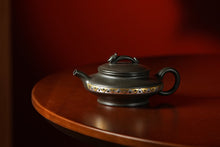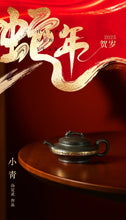
In the long history of purple clay art, the metaphorical art is like a brilliant star shining brightly in the firmament of ceramic aesthetics, occupying the highest level in the aesthetic system. Its poetic aesthetic features, with the help of metaphorical and symbolic techniques, endow the utensils with vivid charm and profound connotations. From the exploration of these expressive techniques by early craftsmen in the history of purple clay, to the presentation of the purple clay modeling art imitating gold and silver wares and bronze wares in the Ming Dynasty, and then to Chen Mansheng's integration of literati's metaphors and symbols, constructing an artistic realm where reality and poetry are intertwined, laying a solid foundation for the development of purple clay art in later generations.
When ceramic artworks incorporate mythological elements, it is as if a door to a fantasy world has been opened, presenting a unique lyrical artistic form. It makes the originally ordinary tea utensils transcend the trivialities of daily life and leads the viewers into an emotional imaginative realm. In terms of visual language, the utensils gradually tend to be symbolic, showing the artistic charm of surrealism and silently interpreting the traditional essence carefully integrated by ceramic artists in their creations.
Today, Tongxin She Teahouse is honored to recommend a limited-edition purple clay teapot handmade by Tang Xuanwu - "Xiaoqing". This teapot is made of fine and smooth materials with excellent texture. The shape of the teapot is flat and hollow, with a bulging belly and a contracted bottom. The lines are smooth and elegant. The design of the curved spout and the handle is natural and harmonious, and it feels comfortable to hold. The knob of the teapot is ingeniously molded into the shape of a snake. The lively snake body looks back expectantly, as if a green snake gracefully appears among the auspicious clouds, vivid and lifelike. In the contrast between the virtual and the real, as well as the movement and stillness, the wonderful posture is fully displayed, and the artistic conception of playing among the clouds and the sea emerges vividly.
The decoration of the teapot body is even more remarkable. It draws on the styles of ancient gold, silver and bronze wares. The gold and silver colors complement each other. The simple decorative patterns exude an ancient charm, which is magnificent and solemn. The decorative patterns closely cooperate with the theme of the teapot, elegant and meaningful, gathering the spiritual energy of mountains and seas. It is like a stroke of genius, adding a touch of ingenuity and interest to the whole utensil. Its craftsmanship is exquisite. From the overall shape to the detailed decoration, every aspect showcases Master Tang Xuanwu's superb skills. The visual effect is excellent, pushing the decorative art of purple clay to the peak, having already surpassed the simple resemblance and achieved a realm of natural charm.
This teapot is named "Xiaoqing", and there is a touching story behind it. Coinciding with the Year of the Snake in Yisi, this name is both fitting for the occasion and has a profound meaning. It originates from the Jinshan Temple hidden deep in the tea-growing area where white tea is abundant in Huzhou, Zhejiang. Jinshan Temple was first built in the Tang Dynasty. The emperor once sent the monk Fahai here, and this Fahai is the prototype of the Fahai monk in the Legend of the White Snake. In the unique interpretation of the myth and legend, Fahai also has the identity of Xu Xian. On the one hand, he is a monk who has renounced the world, and on the other hand, he is a layman in the secular world, hesitating and struggling between the two in his heart. Lady White Snake waited for Xu Xian's return and built an nunnery under the temple for ten years, but only got the chanting of Buddhist scriptures from Fahai. Finally, she was disheartened and went to Jingci Temple beside the Leifeng Pagoda in Hangzhou to become a nun. Xiaoqing, who followed Lady White Snake, is just like the unique "white tea" (actually a special form of green tea under specific temperature conditions) beside Jinshan Temple. Xiaoqing and Xiaobai are both the concerns that Fahai can't let go of in his heart, just like the Huzhou white tea with a mellow taste and a long aftertaste.
When the fragrance of tea curls up slowly, the beautiful scenery is right in front of you. This beautiful legend is integrated into the small tea cup, making people intoxicated and fascinated. The morning bells and evening drums ring out, and the clear water is flawless. Under the Broken Bridge with residual snow, the green snake and the white snake were looking forward to Xu Xian's affectionate company, but unfortunately, the fate was fleeting, just like the fate of a cup of tea. The green leaves float up and down, and the fragrance is simple and elegant. The beauty is only for a moment. However, whether in the hustle and bustle of the secular world or in the tranquility of renouncing the world, the heart of tea is always as pure as ever, just like chanting a poem, enjoying the snow, playing with a purple clay teapot, and adhering to a true love. That Xiaoqing is no longer just a mythological figure, but the original intention that each of us adheres to deep in our hearts. Quietly make a cup of tea, open the window and look out. There are greetings of spring and blessings, white clouds and gentle breezes, and the beautiful landscape in front of you. The good times are all in this cup of tea and this teapot.
It is worth mentioning that during the production process of this teapot, Master Fan Zefeng also provided assistance. The cooperation of the two masters has added unique artistic charm and collection value to this "Xiaoqing" purple clay teapot, making it a treasure in purple clay art, worthy of careful appreciation and collection by tea and teapot lovers.











































